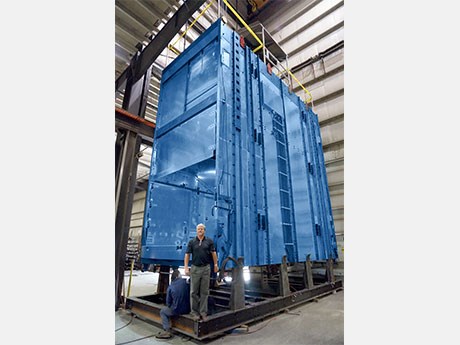Engineered by FLSmidth and manufactured by Stainless Steel Technology
FLSmidth and Sudbury fabricator Stainless Steel Technology are about to deliver two 300-man cages to Freeport McMoRan Copper & Gold’s Grasberg complex in Indonesia.The two identical conveyances, one of which is a spare, are the largest and most technologically advanced cages in the world, according to Jim Brownlee, product manager for FLSmidth. Designed to operate in a sub-vertical shaft, or winze, the two-deck conveyances carry an 85,000-pound material payload and are designed to operate with a Blair multi-rope hoist.
The cages are equipped with continuous load monitoring, LED lighting, a communication system, sensors for door position, a chairing solution and remotely operated wheel chocks to secure rail cars carrying supplies and equipment.
Blair multi-rope hoisting was developed as a solution for very deep shafts in South Africa, but is gaining in popularity in Canada for other reasons, noted Brownlee.
“In Canada, we have a requirement for safety dogs on conveyances. These are a spring-loaded apparatus that deploys teeth into wooden guides to make sure a conveyance will come to a safe stop if the hoist loses control or there is a broken or detached rope.”
The problem though is that the select grade Douglas Fir that’s required for the wooden guides is becoming increasingly hard to source and very expensive.
“It also wears out and has to be continually replaced and maintained, so it’s a huge maintenance issue,” said Brownlee. Galvanized steel guides are an option, but only if there’s a redundant rope.
“For that reason, there’s a lot of interest in BMR hoists.”
Constant power
Because of the relatively short depth that the cages travel, they’re designed with a trailing cable for constant power.
“Usually, when you go in a cage, everybody is standing around with their cap lights on and that’s the only light,” said Brownlee. “This conveyance has LED lighting and a full communication system.”
The cage operator can talk with the control room instead of ringing bells, although the bells will still be there for backup in the event of a power disruption.
Other features of the cage include door sensors that prevent the cage from moving if a door is left open and a chairing mechanism that secures the cage at a level when heavy loads are moved in or out. The operator pulls a handle and four feet shoot out to park the cage.
Freeport McMoRan didn’t want it to be a manual system, “so we designed it to be pneumatically operated with manual as backup,” said Brownlee.
Wheel chocks used for stabilizing rail cars with heavy loads of supplies and equipment are also remotely engaged. The cage won’t leave if the wheel chocks aren’t in place.
The cages are also equipped with Technogrid safety arrestors and FLSmidth Safety Catch Gear with impact buffers –backup safety equipment that is hardly ever used, said Brownlee.
Spare cage
An identical spare cage was required because of the mine’s location and the amount of time it would take to replace and install it. The cages break down into 28 sections for transport to the mine site and down to the sub-vertical shaft for reassembly.
A cavern was excavated to store the spare cage and FLSmidth supplied storage and transfer equipment to move it into position in the shaft.
“If the cage were damaged and they had to order another one, they’d have to shut down the mine for months,” said Brownlee. “They couldn’t take that risk. There are so many men who work down there and if they had to use a ramp, it would take half their shift to get there. By bringing them down in a cage, they can get to work right away.”
FLSmidth, formerly GL&V Dorr-Oliver, closed its Orillia manufacturing facility in 1998, electing instead to outsource manufacturing and focus on engineering and sales.
“The purpose of outsourcing was to have multiple shops to work with, which would give us a pricing and delivery benefit,” said Brownlee. “We have worked with a number of suppliers over the years, but Stainless Steel Technology has emerged as a superior partner for us in every way.”
Stainless Steel Technology has other customers but manufactures skips and cages exclusively for FLSmidth. The company operates out of a state-of-the-art, 55,000-square foot facility in Sudbury’s Lively Industrial Park and boasts a 6 x12-foot laser cutter, a computer-controlled 10 x 24-foot water jet cutter and a robotic welder.
The Sudbury fabricator also has a drop test tower, which eliminates the need for expensive and potentially hazardous drop tests at the minesite.


